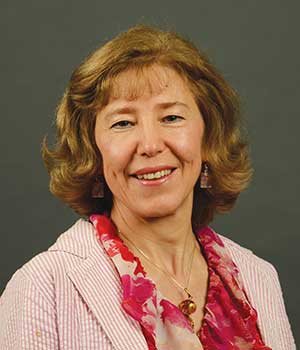Nora Berrah
Chair-Elect of the Nominating Committee
Biographical Summary
Nora Berrah Professor and Head of the Physics Department at the University of Connecticut since 2014. She received her Ph.D. from the University of Virginia in 1987, was a Postdoctoral Fellow (87-89) and an Assistant Physicist (89-91) at the Physics Division at Argonne National Laboratory (ANL) before becoming an Assistant Professor at Western Michigan University (91). She became a full WMU Professor and Distinguished Faculty Scholar in 2000. Berrah was a visiting scholar at the Université d’Orsay, Paris, France, at the Fritz-Haber-Institute der Max Planck Gesellschaft, Berlin, Germany, at the Advanced Light Source (ALS) at Lawrence Berkeley National Laboratory (LBNL), at the PULSE Ultrafast Center, Stanford Linear Accelerator Center (SLAC), and at the Université Pierre et Marie Curie, Paris VI, France. Her research interests are in experimental Atomic, Molecular and Optical Physics for which she received the David. S. Shirley Award for “Outstanding Scientific Achievements” at the ALS, LBNL, a Humboldt Fellowship from the Alexander von Humboldt Foundation, Germany, and a Chair d’Excellence from SOLEIL National Synchrotron Laboratory, France. Berrah is an APS Fellow and the recipient of the 2014 APS Davisson-Germer award.
Berrah served/serves on the AAAS Council Delegate in the Physics Section, the APS Nominating Committee, the APS Division of Atomic, Molecular and Optical Physics (DAMOP) Nominating Committee, the DAMOP Executive Committee twice, The Davisson-Germer Award Committee, the Committee of the Status of Women in Physics, the I. I. Rabi Prize Committee, the APS Committee on International Scientific Affairs, the Executive Committee Division of Laser Science, the National Research Council (CAMOS), the Executive Committee of the Division of Laser Science, the Executive Committee of the APS Topical Group on Few-Body Physics, the Forum on International Physics, and she serves on various review committees for NSF and DoE office of science. She also serves/served on Science Advisory Committees for DoE-BES, for National Research Facilities or for Users Committees of ALS/LBNL, SSRL/SLAC, LCLS/SLAC. She serves on European Union Networks for Research and Innovations, on several International Research Review Committees, National and International conference Program Committees and she co-chaired the International Conference on Photonic, Electronic and Atomic Collisions, ICPEAC XXVI.
Berrah’s research career focuses on the study of the interaction of atoms, molecules and clusters with weak and strong electromagnetic fields produced by various light sources. Her recent research interests are in the areas of non-linear physics, quantum control and time resolved studies of molecules including long and short wavelength radiation, ultrafast time scales and strong laser fields. Her current research involves the use of intense femtosecond table-top lasers and free electron lasers (FELs) in the vuv and x-ray regimes to probe physical and chemical processes that happen on femtosecond time scales. She will be focusing in the near future on investigating attosecond electron dynamics in molecules using non-linear multidimensional methodologies to probe and control the motion of electrons within molecules and determine how those dynamics influence the earliest stages of photo-induced molecular physics.

Statement
The American Physical Society plays a vital national and international role by advancing and publishing the knowledge of physics, and by representing scientists in academia, national laboratories, and industry in the U.S. and around the world. APS has grown over the years to be one of the most respected societies because of its many programs, which benefit not only physics but also other scientific fields. APS should continue to grow and communicate effectively the excitement of physics discoveries and their impact on not only fundamental science but also to industry, and thus impacting the global economy and society in general.
APS leadership needs to articulate and explain to congress and the public the unique and essential role physics plays in addressing our nation’s needs and the global economy. The role of the new leadership should extend the current role of APS, increase our influence in all matters that concern the growth of APS and research/education funding as well as strengthen and expand the connections with our international sister societies. I would be honored to work with the nominating committee to identify the best slate of candidates by bringing my perspective working at universities, national and international facilities and from my services (national and international committees, physics education, diversity and inclusion and outreach). As chair-elect, I would be diligent in persuading outstanding candidates to stand for election.

